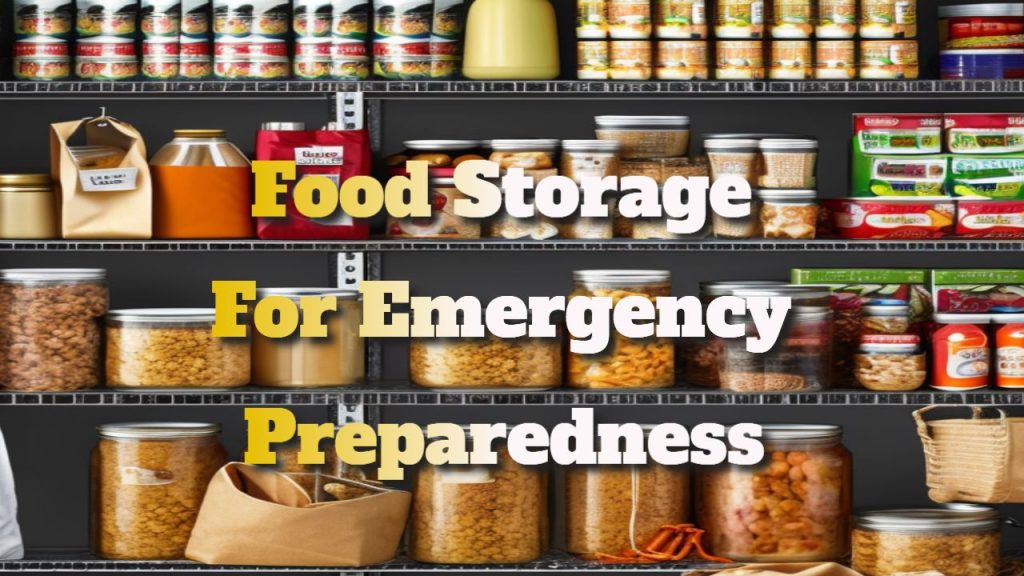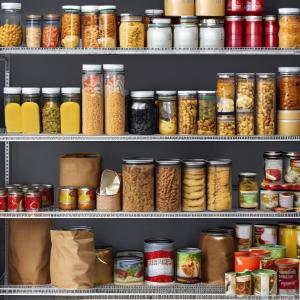Essential Strategies for Effective Emergency Food Storage
Did you realize that a staggering 60% of Americans are not adequately prepared for emergencies? Having a well-stocked pantry can act as a lifesaver when disaster strikes. But where should you start? How can you guarantee that your food supply is sufficient and properly maintained? In this comprehensive guide, we’ll delve into everything you need to know about emergency food storage, including the types of food to keep on hand and the most effective methods for storing and rotating your supplies. Read on to discover how to safeguard yourself and your loved ones during times of crisis, whether you’re an experienced prepper or just beginning your journey into emergency preparedness.
Understanding the fundamentals of food storage can make a significant difference in your readiness for unforeseen events. The right approach can ensure that your food remains accessible, nutritious, and safe for consumption when it is needed the most.
Understanding the Importance of Proper Food Storage
Proper food storage is crucial for maintaining freshness and minimizing waste. When food is stored correctly, it not only has a longer shelf life but also ensures safety for consumption. By keeping perishable items at the right temperatures and conditions, you can significantly slow down bacterial growth and preserve food quality. This proactive approach leads to fewer grocery store trips and a notable reduction in food waste, ultimately saving you money.
Furthermore, organized storage allows you to quickly assess your pantry and refrigerator, helping you avoid unnecessary purchases. Keeping your food well-stored means you can enjoy delicious and nutritious meals while minimizing waste, contributing to a more sustainable lifestyle.
Essential Non-Perishable Foods for Emergency Preparedness
It is vital to keep a stock of basic food supplies readily available for emergencies. These items should be non-perishable, easy to prepare, and packed with the necessary nutrients to sustain you during a crisis. Start by stocking canned goods such as vegetables, fruits, and protein sources like tuna or chicken. They are not only versatile but can also be consumed straight from the can or incorporated into various recipes.
Don’t forget about grains like rice and pasta, which are incredibly versatile and can be stored for extended periods. Additionally, consider dried beans and lentils, which are excellent sources of protein and have a long shelf life. Lastly, include comforting items such as chocolate or snacks to boost morale during challenging times.
Effective Storage Techniques for Long-Lasting Supplies
Begin by storing your food in a cool, dry area with a consistent temperature. Avoid extreme heat or humidity, which can accelerate spoilage and damage. To further protect your food, use airtight containers or vacuum-sealed bags to prevent exposure to air and moisture. This practice preserves your food’s flavor, texture, and nutritional content, ensuring that it remains safe and enjoyable to eat.
Understanding Shelf Life and Smart Rotation Practices
Being aware of the shelf life of your supplies is essential for determining when to use or replace specific items. Most emergency foods have a shelf life that ranges from 1 to 25 years, depending on the food type and its packaging. Check expiration dates regularly and replenish your supplies as needed, ensuring that you consume older items first and replace them with new stock.
Key Considerations for Maintaining Emergency Food Quality
Proper storage is crucial for preserving both the longevity and nutritional value of your emergency food supplies. Always ensure that your storage area is cool, dry, and shielded from direct sunlight, as high temperatures and humidity can accelerate spoilage. Use airtight containers to keep food fresh longer and protect it from pests and oxygen exposure, thus enhancing food quality and safety.
Labeling and dating your food containers is a critical step to track expiration dates and facilitate proper rotation of supplies. Regularly inspect your emergency stock for any signs of damage or spoilage, replacing items as necessary. By taking these precautions, you can ensure that your emergency food supplies remain safe, nutritious, and ready for use when the time comes.
Frequently Asked Questions About Emergency Food Storage
What are the most common mistakes to avoid when stockpiling food for emergencies? There are several typical pitfalls that can hinder your preparedness efforts. One major mistake is neglecting to rotate your supplies regularly. To ensure nothing goes to waste, check your food stockpile frequently and consume the oldest items first.
Another common error is failing to seal containers properly. To minimize spoilage and contamination, it is crucial to use airtight containers for your emergency food storage. This practice aids in maintaining the quality and safety of your food reserves.
Additionally, when organizing your emergency food supplies, be mindful of dietary restrictions or allergies. Planning for options that cater to the unique needs of all household members will ensure everyone stays well-nourished during a crisis.
Is it Necessary to Invest in Specialized Food Storage Containers?
While it may be tempting to use standard household containers, investing in proper food storage solutions is advisable. Regular containers may not provide the necessary airtight seal or durability required for long-term food storage. Ensuring the safety and longevity of your stored supplies is essential for effective emergency preparedness.
Tips for Keeping Your Emergency Supplies Safe During Power Outages
Follow these essential guidelines to maintain the safety of your food during a power outage:
1) Store food in a cold, dry location to prevent spoilage.
2) Use tightly sealed containers to protect against contamination.
3) Regularly update your food stock and monitor expiration dates.
Are there additional considerations for those with dietary restrictions or food allergies when stockpiling food? Absolutely! It is vital to consider individual dietary needs while preparing your emergency food supplies. Make sure to select foods that meet those requirements without posing health risks.
How can I creatively incorporate emergency food supplies into daily meals to minimize waste? Get inventive with your emergency rations! Incorporate canned fruit into smoothies, add dehydrated vegetables to soups, or create pasta dishes with canned meats. Experimenting with various ingredients can help you reduce waste while enjoying nutritious meals.
A well-stocked and properly stored emergency food supply is an indispensable aspect of any preparedness plan. Grasping the importance of effective food storage, identifying essential items, and managing them efficiently can significantly enhance the longevity and quality of your emergency provisions.
Make it a habit to regularly check the shelf life of your stored items and rotate them as necessary. By considering these factors, you’ll be prepared for any unforeseen circumstances that may arise. Stay safe and prepared!
The post Essential Strategies for Effective Emergency Food Storage appeared first on Survival Avenue.
The Article Essential Strategies for Effective Emergency Food Storage was found on https://limitsofstrategy.com




It’s surprising to think that 60% of Americans are unprepared for emergencies, particularly in a time when natural disasters and uncertainties seem to be more frequent. I’ve found that understanding the basics of food storage not only increases one’s preparedness but also fosters a sense of control and peace of mind.
You raise a valid point about the unsettling statistics regarding Americans being unprepared for emergencies. It does seem counterintuitive, especially when we see the news filled with stories about unpredictable weather patterns, fires, and other emergencies that can turn lives upside down in an instant.
You make a great observation about the dissonance between our awareness of these emergencies and the actual preparedness levels of many people. It’s interesting how we can become so accustomed to hearing about disasters that they almost feel like a distant reality—something that happens to others but not to us. It reminds me of the psychological concept of “normalcy bias,” where we convince ourselves that things will continue to go as they always have, even in the face of evidence to the contrary.
It really is concerning that so many people are unprepared, especially when you think about how often we hear about extreme weather events or other emergencies in the news. The emphasis on food storage is so important, not just for emergencies but as a part of living a more sustainable lifestyle overall. I’ve found that practicing food storage and preservation techniques, like canning or fermenting, can be a fun way to develop skills that benefit both our wellbeing and the planet.
You’ve touched on a really important point about preparedness and how it connects to our everyday lives. It seems ironic that with so much information about extreme weather and emergencies flooding our screens, we still find ourselves caught off guard. It’s great to hear you’re actively engaging with food storage; the skills you mentioned, like canning and fermenting, are not just practical – they also bring a sense of satisfaction and connection to our food.
It’s really eye-opening to think about that statistic—60% feeling unprepared truly highlights a gap in awareness and resources. In my own experience, delving into food storage has indeed turned into a fulfilling project. It’s not just about having enough during an emergency, but it feels like a form of self-care. Knowing that I can whip up meals from what I’ve stored brings a level of comfort that’s hard to replicate otherwise.
Your exploration of emergency food storage is crucial, especially considering that a significant percentage of the population remains unprepared. I can relate to this topic on a personal level, as I once experienced a situation where having a well-stocked pantry could have alleviated a great deal of stress during a localized power outage. It made me realize that preparation isn’t just about having supplies; it’s about peace of mind.
Your post raises an essential conversation about emergency preparedness and the staggering statistics on unpreparedness among Americans. It’s interesting to consider not just the logistics of food storage, but also the psychological aspects of being prepared for emergencies. In my experience, taking the time to build a well-stocked pantry can provide a sense of control and security in an otherwise uncertain world.
You bring up such an interesting point about the psychological aspects of being prepared for emergencies. I’ve noticed that in times of uncertainty, having a well-stocked pantry can really shift your mindset. It’s surprising how something as simple as knowing you have enough food on hand can alleviate anxiety. I remember a few years back when there were all those wildfires nearby, and while I wasn’t directly in the path, the sense of looming threat had everyone on edge. I spent that time prepping, not just for potential evacuations, but also for the peace of mind that comes with being ready.
Your insights on preparedness resonate deeply; speaking of local resources, I recently came across an article that explores the joy of indulging in seasonal seafood, which adds another layer to both food security and enjoyment during uncertain times.
‘Queen Conch Season: Delight in Local Seafood Treats!’
https://blogpeeper.com/queen-conch-season-delight-in-local-seafood-treats/.
You bring up a really important point about the psychological aspects of being prepared. It’s fascinating how small actions, like stocking up a pantry, can significantly impact our mental well-being. I’ve found that when I take the time to prepare, it alleviates some of the anxiety that comes with the unpredictability of life, especially during events like natural disasters or public health crises.
You bring up a really important point about the psychological aspects of being prepared. It’s interesting how that simple act of stocking up a pantry can shift our mindset. I’ve noticed that when I take proactive steps to prepare, like planning meals or ensuring we have essentials, it creates a sense of control amidst uncertainty. In many ways, it’s therapeutic—engaging in those small rituals can ground us when everything else feels chaotic.
It’s so interesting to see the conversation around emergency food storage gaining traction, especially considering how many of us might take our pantries for granted in our day-to-day lives. The statistic you share about 60% of Americans being unprepared is quite alarming. It really highlights the gap between awareness and action that exists in our society, particularly in a culture that often prioritizes convenience over preparedness.
This blog post raises a crucial point about food preparedness, especially considering the unpredictability of emergencies. Reflecting on my own experience, I found that starting with a simple inventory of what my family consumes regularly made a significant difference. By focusing on familiar foods, we avoided the panic of having a pantry filled with unappetizing options when it mattered most.
You bring up a really important aspect of food preparedness that often gets overlooked—the personal touch that comes with knowing what your family actually likes to eat. It’s easy to get caught up in the idea of stocking up on survival foods and lose sight of what makes mealtime comforting when things feel chaotic. Your approach of starting with an inventory of regular, favorite foods is spot on.
I really resonate with your experience of starting with an inventory of what your family regularly consumes. It’s such a simple yet effective strategy that can truly reduce stress during unexpected emergencies. During the early days of the pandemic, I noticed a similar theme across many families: those who had taken the time to stock up on familiar foods felt more secure and prepared.